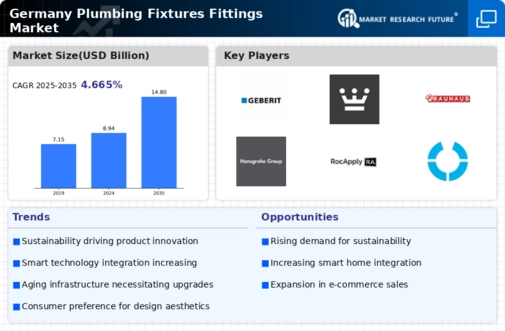Urban Infrastructure Development
Urban infrastructure development plays a crucial role in shaping the plumbing fixtures-fittings market in Germany. As cities expand and modernize, there is a growing need for efficient plumbing systems in residential and commercial buildings. The German government has initiated several urban development projects aimed at enhancing infrastructure, which in turn drives demand for high-quality plumbing fixtures. The market is expected to benefit from these initiatives, with an anticipated growth rate of 5% annually over the next few years. Additionally, the trend towards smart cities is likely to further stimulate demand for advanced plumbing solutions that integrate seamlessly with modern urban infrastructure.
Regulatory Compliance and Standards
The plumbing fixtures and fittings market in Germany is significantly influenced by stringent regulatory compliance and standards. The German government enforces various regulations aimed at ensuring safety, efficiency, and environmental sustainability in plumbing installations. For instance, the Energy Saving Ordinance mandates that plumbing fixtures must meet specific energy efficiency criteria. This regulatory landscape compels manufacturers to innovate and adapt their products to comply with these standards, thereby driving market growth. Furthermore, adherence to these regulations can enhance product appeal, as consumers increasingly prefer fixtures that align with environmental standards. The market is projected to grow at a CAGR of approximately 4.5% over the next five years, driven by the need for compliance with evolving regulations.
Rising Consumer Awareness and Preferences
Rising consumer awareness regarding water conservation and energy efficiency is a pivotal driver for the plumbing fixtures-fittings market in Germany. As consumers become more informed about the environmental impact of their choices, there is a marked shift towards products that promote sustainability. This trend is reflected in the increasing demand for low-flow faucets and dual-flush toilets, which can reduce water usage by up to 30%. Additionally, consumers are showing a preference for fixtures that incorporate smart technology, allowing for better monitoring and management of water consumption. This heightened awareness is likely to propel market growth, as manufacturers respond by developing innovative products that meet these evolving consumer preferences.
Technological Advancements in Manufacturing
Technological advancements in manufacturing processes are reshaping the plumbing fixtures-fittings market in Germany. Innovations such as 3D printing and automation are streamlining production, reducing costs, and improving product quality. These technologies enable manufacturers to create customized solutions that cater to specific consumer needs, enhancing market competitiveness. Moreover, the integration of advanced materials, such as corrosion-resistant alloys and eco-friendly plastics, is becoming prevalent. This shift not only improves the durability and functionality of plumbing fixtures but also aligns with the growing consumer demand for sustainable products. As a result, the market is expected to witness a robust growth trajectory, with an estimated increase in market value reaching €2 billion by 2027.
Aging Infrastructure and Renovation Projects
The aging infrastructure in Germany presents a significant opportunity for the plumbing fixtures-fittings market. Many existing buildings require extensive renovations to meet current standards and consumer expectations. This need for renovation is particularly pronounced in older urban areas, where outdated plumbing systems can lead to inefficiencies and safety concerns. As property owners and developers invest in upgrading these systems, the demand for modern plumbing fixtures is expected to rise. The market could see an increase in value, with renovation projects projected to account for approximately 40% of total market growth in the coming years. This trend underscores the importance of innovation and quality in meeting the demands of a changing infrastructure landscape.






















Leave a Comment